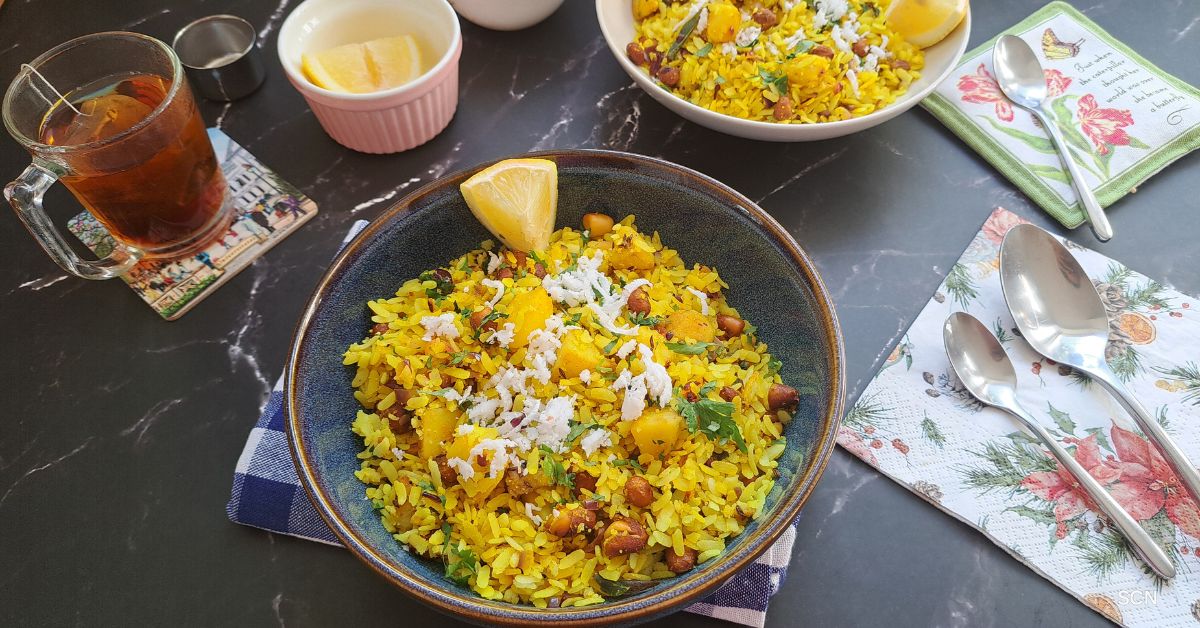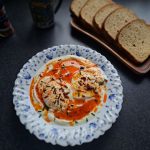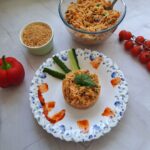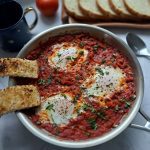Batata Poha

Batata Poha is a traditional and popular breakfast dish from Maharashtra, India. The name “Batata Poha” comes from the Marathi words “Batata,” meaning potato, and “Poha,” which refers to flattened rice. This dish boasts simplicity, quick preparation, and delicious taste. Many Indian households consider it a staple due to its nourishing qualities. It features the warmth of turmeric, the crunch of peanuts, and the zest of fresh lemon juice. You can enjoy them plain or garnish with fresh coriander or grated coconut.
Poha
Poha, also known as “aval” in Tamil Nadu and “chura” in Bihar, has been a part of Indian culinary traditions for centuries. It has spread across the country, with each region adding its unique twist to the dish. In Maharashtra, it’s garnished with grated coconut and sev, while in Madhya Pradesh, it’s served with jalebi, creating a balance of sweet and savoury flavours. You can serve them as a snack or a light meal at any time of the day.
The simplicity and nutritional value of Poha
One of the reasons Poha is so beloved is its simplicity. The main ingredient, flattened rice, is easily available and requires minimal cooking. A quick rinse under running water, and you’re ready to transform it into a delicious dish. Start by cooking the potatoes, sautéing onions, peanuts, green chillies, and spices like turmeric in oil. Then, add the soaked poha and cook it until everything is well combined. This simplicity makes it the perfect breakfast for busy mornings when you need a wholesome meal in no time.
Nutritionally, Poha is a powerhouse. Flattened rice is light and easy to digest, making it ideal for breakfast. It is a good source of carbohydrates, providing the energy needed to start the day. The addition of peanuts not only adds a delightful crunch but also contributes protein and healthy fats. Turmeric, a staple in Indian cooking, brings its anti-inflammatory properties to the dish. The fresh squeeze of lemon juice at the end enhances the flavour and provides a dose of vitamin C. Garnished with coriander leaves, which are rich in antioxidants, it is not just delicious but also a balanced meal that nourishes the body.
The regional variations of Poha
What makes Poha truly unique is its adaptability. While the basic ingredients remain the same, the dish takes on different forms as you travel across India. In Maharashtra, Kanda Poha (onion poha) is the most popular version, characterized by the sweetness of onions balanced with the tanginess of lemon. Poha is topped with sev and served with a side of jalebi in Indore.
In Gujarat, Batata Poha includes the addition of boiled potatoes, adding a creamy texture to the dish. The southern states of India have their versions, too, with some incorporating grated coconut and curry leaves, lending a distinctly South Indian flavour profile. Whether you’re enjoying a plate of Kanda Poha in Mumbai or savouring a sweet and savoury combo in Indore, it is a dish that brings comfort, joy, and a taste of home with every bite.







Batata Poha
Ingredients
1 cup = 250ml
- 2 ½ cups thick Poha flattened rice
- 1 medium onion finely chopped
- 2 medium potatoes peeled and diced
- 1-2 green chillies finely chopped
- ¼ cup peanuts
- ½ tsp mustard seeds
- ½ tsp cumin seeds
- ½ tsp turmeric powder
- 1 tsp sugar optional
- Salt to taste
- 2 tbsp oil
- Juice of one lemon
- Fresh coriander leaves chopped
- Few curry leaves
- A few tablespoons of water
- ¼ cup grated coconut for garnishing, optional
Instructions
- Place the poha in a bowl and add water. Gently rinse and sieve through the strainer. Make sure the poha is softened but not mushy. Leave it in the strainer to drain excess water.
- Heat oil in a pan over medium heat. Add the cumin and mustard seeds and let them splutter.
- Add curry leaves and green chillies to the pan. Sauté for a few seconds.
- Then add the peanuts and fry until golden brown. Then add the diced potatoes and cook until soft.
- When the potatoes are half cooked, add the chopped onions and cook until they turn translucent.
- Once the potatoes are cooked, reduce the heat to low, add the turmeric powder and salt to the pan. Saute for a minute and add poha and sugar (if using). Mix gently to combine everything without breaking the poha.
- Add coriander leaves and lemon juice and combine well.
- Add a splash of water, cover the pan and let it cook for 1 minute on low heat, allowing the flavours to meld.
- Turn off the heat and let it rest for 5 minutes.
- Garnish with more chopped coriander leaves. If using, sprinkle some grated coconut on top.
- Serve the poha hot with an additional squeeze of lemon juice if desired.
Notes
- Use medium or thick poha for a better texture. Thin poha tends to get mushy quickly. Rinse the poha gently under running water until it softens. Do not soak it for too long, as it may become mushy. Drain well to remove excess water.
- After adding the poha to the pan, cook it on low heat to ensure it absorbs all the flavours without getting overcooked.
- Poha is best enjoyed fresh and warm. If left sitting for too long, it may lose its fluffiness and become dry.
Frequently asked questions
Poha, also known as flattened or beaten rice, is a popular Indian breakfast dish that people make from rice flakes. It is sautéed with onions, potatoes, green chillies, and various spices to create a light, flavourful meal.
Yes, for making traditional poha dishes like Kanda Poha or Batata Poha, it’s best to buy thick poha. Thick poha retains its shape well during cooking, absorbs flavours nicely, and doesn’t become mushy, ensuring that your dish has the perfect texture and taste.
To prepare Poha, rinse the rice flakes under running water until softened, then sauté them with ingredients like onions, potatoes, peanuts, and spices like turmeric. Finish with a squeeze of lemon juice and garnish with fresh coriander.
Yes, It is light, easily digestible, and a good source of carbohydrates. When prepared with peanuts, it also provides protein and healthy fats. Additionally, you can customize them with vegetables to increase their nutritional value.
Enjoy Poha best when it’s fresh. Prepare the ingredients in advance, such as chopping vegetables. However, cook the final dish just before serving to ensure the best texture and flavour.
Absolutely! You can customize them with various vegetables like peas, carrots, bell peppers, or tomatoes to enhance its nutritional content and flavour.
The key to preventing mushy Poha is to rinse it lightly under water until softened but not soaked. Let it drain completely before adding it to the pan. Avoid overcooking after adding Poha to the sautéed ingredients.
Poha is traditionally served warm, some variations like Dadpe Poha are meant to be enjoyed cold. You can eat the leftover poha at room temperature, but it’s generally more flavourful when warm.
Enjoy Poha best when it’s fresh, but you can store leftovers in an airtight container in the refrigerator for up to 1-2 days. Reheat it gently in a pan or microwave before serving.

1 thought on “Batata Poha”